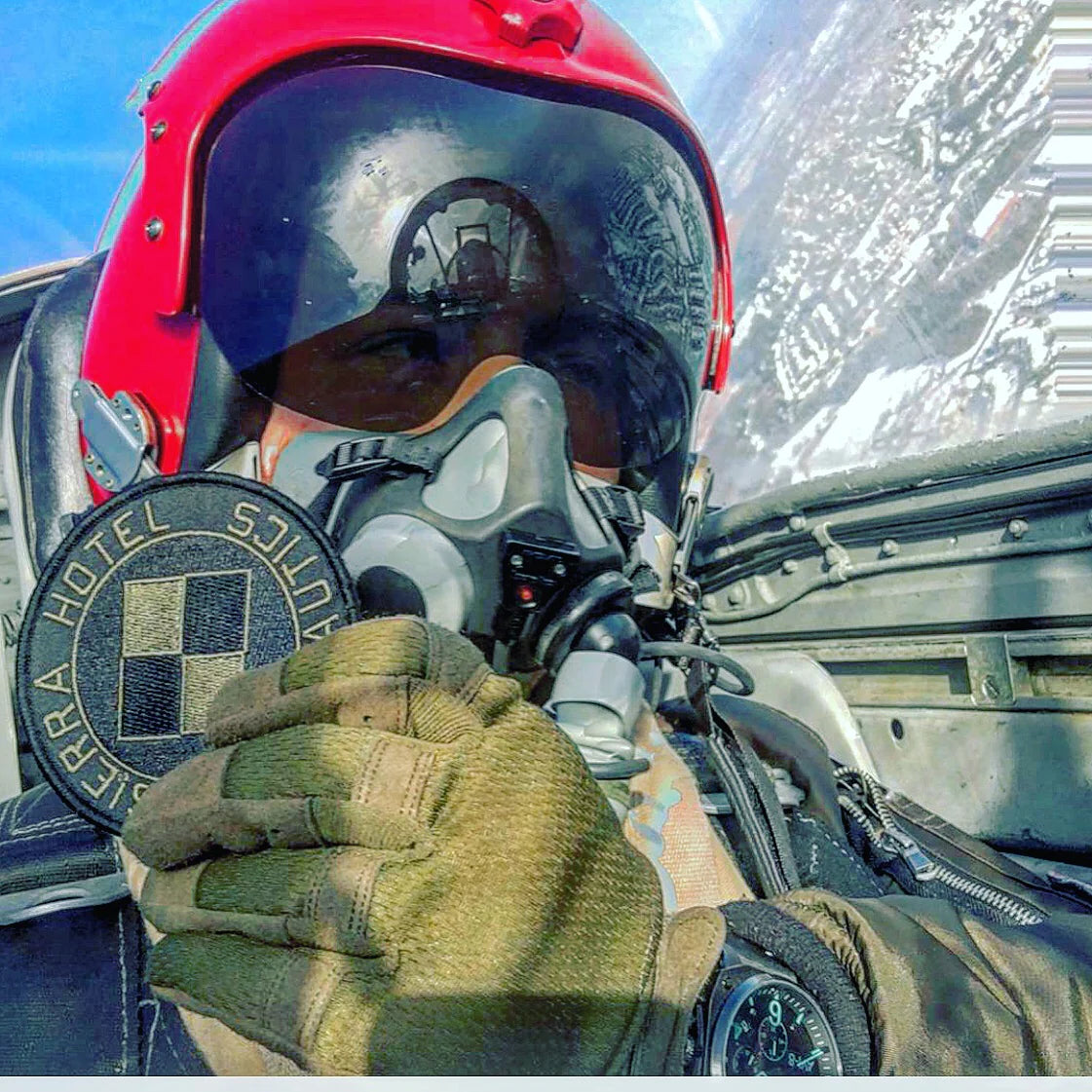When a B-52 Bomber Lost its Tail!

The photo tells much about the story of a B-52H Stratofortress long-range bomber tail #61-023 airborne over the US with most of her vertical stabilizer sheared off, rear landing gears down for stabilization.
It was widely known that a typical low-altitude, high-speed flight profile puts enormous stress on the B-52's structure. That would be especially true when flying near mountains and up and down their ridges and valleys, which is what would have to be done when penetrating the Soviet Union in a nuclear attack.
Jim Goodell, a Boeing test pilot, tells that John Rutherford, a colleague, would take the B-52 over to the Rockies, start at the bottom of a 10,000 ft. ridge at 325 knots, and hump over the top at about 200 knots, with the crew wondering if he would run out of speed before he made it over. But making it over the top was just one problem. Going down the other side, especially if it is the leeward side, presented other tough challenges. There's a lot of science behind what is referred to as wind rotors. We will simply say that if your aircraft gets caught in one, the pilot has his hands full. If his aircraft were not made to withstand this kind of turbulence, then it gets even worse.
As we will describe later, the Air Force early on experienced tail sections and stabilizers breaking off, her enormous wings were experiencing considerable fatigue, and aircraft were crashing and crews were being lost. As a result, the Air Force tasked Boeing to conduct aggressive low-altitude testing.
Chuck Fisher's B-52H No. 061-023 was loaned to the USAF to conduct the test flights. Boeing outfitted her with 20 accelerometers and over 200 sensors to measure and record stresses on the airframe.
Boeing test pilot Chuck Fisher and a crew of three were tasked to take 023 out for a shakedown flight, and get the structural recordings needed to evaluate what to do to enable this aircraft to fly the profile it would have to fly to take down the Soviets.
While over Colorado on January 10, 1964, Fisher was flying at 500 ft. and hit turbulence. The tests had been running smoothly prior to that, so he aborted this part of the flight plan. The crew took a short lunch.
Fisher then climbed to 14,300 ft. looking for smoother air. Speed was reported at 350 Knots Indicated Air Speed (KIAS). At about that altitude, he hit severe clear air turbulence that rattled the aircraft all over the sky. Fisher was about five miles east of the Sangre de Christo Mountains in Mora, New Mexico, not far from southern Colorado.
James Pitman, the Boeing navigator, said this:
"When this event occurred it was so violent that I was literally picked up and thrown against the left side of the airplane and over the navigator's table."

Fisher commented:
"I had the rudder to the firewall, the control column in my lap, and full wheel input and I wasn't having any luck righting the airplane. In the short period after the turbulence I gave the order to prepare to abandon the airplane because I didn't think we were going to keep it together."
Immediately after the severe turbulence, the jet rolled hard right and almost went out of control. Fisher said this:
"It required about 80 percent left wheel throw to control the aircraft by the time things had settled down."
Fisher descended to 5,000 ft. and advised the crew to prepare for bailout. Then, almost miraculously, he regained control. He climbed back up to 16,000 ft.
Fisher was flying, but he was experiencing a lot of stability problems. He knew he had problems, but he did not know the full extent what they were.
Much like we have seen done when there are problems with space flights, Boeing's Wichita plant assembled the pros, civilian and USAF, into an Emergency Control Center (ECC) to figure out what to do. Wichita launched one of its F-100 chase aircraft to conduct a visual check. In the mean time, Fisher would have to keep his aircraft aloft and give the ECC as much information as he could provide.
After marrying up with the beleaguered B-52, Felix reported that Fisher had lost his vertical tail. This explained a lot. It meant he had lost his vertical fin and rudder, which, in turn meant he had no directional stability. The aircraft could have rolled or gone down. Fisher put down the rear landing gear to add some stability and flew the rest of the flight in that configuration. Note the tail stub that remained. That turned out to be helpful.
The engineers and pilots worked the problem for six hours while Fisher and his crew kept the aircraft in the air. A USAF B-52 on a routine training flight launched to test various flight configurations the beleaguered test aircraft might use to land.
A plan emerged. Winds were high at Wichita so it was scrubbed as a landing site. Instead, Eaker AFB, Blytheville, Arkansas was selected. It hosted the 97th Bombardment Wing (BW) flying the B-52G and KC-135A tankers, so the airfield and support people and equipment were suited to the job of recovery. Winds at Blytheville were calm, and the area was sparsely populated should there be a crash. Furthermore, Fisher could take a southern route to Blytheville that would avoid having to deal with the down-slope winds off the Rockies.
The plan called for the following: transfer on-board fuel to different tanks to account for the lost weight of the vertical stabilizer and adjust the center of gravity accordingly; change engine settings for descent and landing from those normally used; apply only a small amount of air brakes; set landing speed at 200 knots.
A KC-135 tanker with engineers aboard launched to serve as an airborne control center and escort aircraft.

On approach to Blytheville, Fisher lowered the front gear. You will recall he much earlier lowered the rear gears to add stability. The front gear coming down made the aircraft yaw but everything settled down once the gear was fully extended.
Fisher landed the aircraft safely. And with that success, the engineers were able to get the recorded structural data to develop long term solutions.
These recordings showed that a gust hit the aircraft with a hurricane force. We have seen one report that said the gust was 81 mph. A Boeing memorandum of January 24, 1964 purportedly said the following:
"... flown through an area containing the combined effects of a (wind) rotor associated with a mountain wave and lateral shear due to airflow around a large peak ... Gust initially built up from the right to a maximum of about 45 feet per second (TAS), then reversed to a maximum of 36 feet per second from the left, before swinging to a maximum of about 147 feet per second from the left followed by a return to 31 feet per second."
Our calculation of 147 feet per second is about 100 mph.

Fisher would later recount, as reported in Aerospace Safety, April 1964:
"As the encounter progressed, a very sharp- edged blow which was followed by many more. We developed an almost instantaneous rate of roll at fairly high rate. The roll was to the far left and the nose was swinging up and to the right at a rapid rate. During the second portion of the encounter, the airplane motions actually seemed to be negating my control inputs. I had the rudder to the firewall, the column in my lap, and full wheel, and I wasn’t having any luck righting the airplane."
Ray Lahr, a graduate engineer from USC and former Navy WWII pilot, commented on Fisher's crash. He said that the B-52 design caused the vertical stabilizer to be placed more forward than usual, causing the entire fuselage to be a stabilizing force in a feathered arrow effect, a good thing in this case. Furthermore, he added that the entire stabilizer did not break off, which allowed enough lateral stability to make a constructive, positive difference.
We have seen one report that reflects the importance of Chuck Fisher bringing his Buff in safely. This report said that the data showed that turbulence would over-stress the rudder connection bolts, causing a rudder and then a tail failure. This report said the bolts were strengthened which fixed the problem.
Fisher's B-52H Nr. 61-023 remains in service with the USAF. It is presently assigned to the 20th Aircraft Maintenance Unit, Barksdale AFB, Louisiana, where it is kept mission capable for the 20th Bomb Squadron. Staff Sergeant Michael Rochette is her current crew chief, and loves his bird. that's what Chuck Fisher said, even after this flight:
"(The B-52) is the finest airplane I ever flew."












Remember that quite well. Was assigned to the A/R shop.. Ii think that was the T33 we hauled to Jackson MO. And put on display at the park??
I was assigned to the 97th Fms, Aero repair shop a ND helped install the new. Vertical stabilizer and rewire some recorder points
Why was that bird carrying Houndog Missles? You can see one under the wing in the color photograph. Also, I believe the base name was Blytheville AFB. I was stationed there in the 70s.
One small item that is never reported in this article. I was stationed at Blytheville on the day of this emergency. I was the NCOIC of security while this was happening. The Commanding General of our Wing was stationed at Barksdale AFB in Louisiana, and he decided to fly to Blytheville AFB to be present at the landing. He flew into Blytheville AFB in a T-33 and came in for a landing. However, he forgot to lower his landing gear and crashed on the runway the B-52 was to land on. The quick and efficient ground crew was able to
clean up the wreckage and the B-52 was able to land safely without any further problems
B52 crew Chief back in the day, I think it means full 100% rudder
Leave a comment